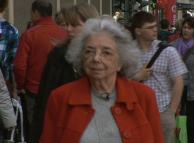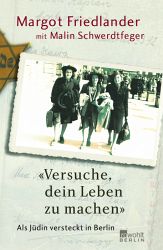Margot Friedländer

Buch:
Versuche, dein Leben zu machen
Als Jüdin versteckt in Berlin

Buchbesprechung:
http://www.perlentaucher.de/buch/29312.html
TV Interview (Berlin - auf Deutsch) Teil 1:
http://www.tvbvideo.de/video/iLyROoafJhPg.html
TV Interview (Berlin - auf Deutsch) Teil 2:
http://www.tvbvideo.de/video/iLyROoafJhPs.html
Artikel (auf Deutsch):
http://www.ad-hoc-news.de/margot-friedlander-ueberlebte-den-holocaust-im-kz--/de/Nachrichten/21199634
RBB Video:
http://www.rbb-online.de/abendschau/7plus/zerstoerte-vielfalt-margot-friedlaender.html
Späte Rückkehr (Deutsche Welle Sendung):
http://www.dw-world.de/dw/article/0,,6206142_page_1,00.html
Späte Rückkehr:
http://www.rbb-online.de/doku/titel_mit_s/spaete_rueckkehr.html
Teil 1: Abschied von New York
Vor 63 Jahren, 1947, emigrierte Margot Friedländer zusammen mit ihrem
Mann nach New York. Beide hatten die Shoah überlebt; Margot im
Untergrund ihrer Heimatstadt Berlin. 2003 besuchte sie zum ersten Mal
wieder die deutsche Hauptstadt. Es ist eine Reise in ihre Vergangenheit
und in die Stadt, in der sie versteckt von Deutschen den Naziterror
überlebt hatte.
Doch diese Reise hat ihre Einstellung verändert: 2010 möchte Margot
Friedländer nun für immer nach Berlin zurückkehren. Doch der Abschied
von New York und den amerikanischen Freunden fällt nicht so leicht wie
gedacht…
Teil 2: Ankunft in Berlin
Vor 63 Jahren, 1947, emigrierte Margot Friedländer zusammen mit ihrem
Mann nach New York. Beide hatten die Shoah überlebt; Margot im
Untergrund ihrer Heimatstadt Berlin. 2010 kehrt sie für immer in die
deutsche Hauptstadt zurück. “Heimat”, sagt Margot Friedländer, “hat sie
keine, aber ein Zuhause.” Und das ist jetzt wieder in Berlin. Ihre
Mission der Versöhnung ist es, der jungen Generation zu berichten, wie
ihr Deutsche geholfen haben, den Naziterror zu überleben – auch damit
er nicht in Vergessenheit gerät. Doch Vertretern ihrer Generation
traut sie bis heute nicht ...
Information about the original English version:
“DON’T CALL IT HEIMWEH” / 60 minutes Feature Documentary by
Thomas Halaczinsky
The Woodstock Film festival called the film “A moving and unsentimental
tale of one woman’s indomitable will to survive.”
The Greeks call it nostalgia, - in German “Heimweh” the unappeased
yearning to return. The 60 minutes road movie documentary tells
the story of a life long search for home and identity. It is a
compelling look inside the conflicted mind of 82 year old Margot
Friedländer who survived Nazi Germany hidden by Germans.
This is not just another “Holocaust documentary”, but the story of a
courageous woman immigrant who found a mission late in life.
When her husband died Margot Friedländer had lost her best friend and
companion for 53 years. Now without children or any other
relatives she was all by herself. She came to realize that for 53
years she had had her husband decide about her life. At first she
felt abandoned and lost, but then she started to search for herself and
through a memoir writing class at the 92nd Street Y in New York she
rediscovered her own story.
It was then that she felt the urge to reconnect with her home country
Germany that she had left together with her husband almost 60 years ago
after the war. She had lived a good middle class life in Queens
New York trying to be a good American, but looking back she painfully
remembered another country and another time. Although America had
become her new home, she now felt that she didn’t have to be grateful
to America: After all this country had done nothing for her when she
desperately needed its help.
60 years of silence about her past and what she had endured as a young
girl suddenly broke; childhood memories and the unanswered question
where to belong to surfaced. Thoughts about her father and mother
kept her awake during countless nights when she wrote her life story.
Why did her father abandon the family in the darkest of times and why
did her mother leave her when she needed her most?
“Don’t call it Heimweh” insisted her cousin Jean – a forbidden feeling
for anyone who had lost the entire family to the murderous hands of
Nazi Germany.
Who are theses Germans today and how do they relate to their history
wondered Margot just to discover on her first trip back to her home
town
Berlin that most of the 3rd generation Germans didn’t know any stories
like hers.
How could it have happened that a young Jewish girl survived hidden by
Germans? Haven’t generations told us, that there was nothing the
Germans could have done to defeat the overwhelming power of fascism?
It helped that she was a young good looking girl and even though it is
never openly admitted, it becomes clear that Margot often had to return
the favor of getting shelter for a night. A married man helped
her to get plastic surgery in the middle of the war to alter her
appearance and to blend in with the Germans. After 13 months of
hiding she was betrayed by Jewish catchers who fearing for their own
life collaborated with the Nazis in Berlin.
The film is entirely set in present time and avoids the all too often
seen archival footage. It is a visual narrative that connects the
various pieces and impressions of her compelling story. Elements of
cinema vérité are mixed with associative images that correspond with
her memories.
While this film is rooted in history it is not a historical film. Much
more it is the attempt to show the individual necessity to transcend
the experience of pain and suffering when one grows older and has to
come to a conclusion in life.
Margot’s journey to Berlin reveals how much modern day Germany still
struggles to relate to its horrible history. In Germany’s new
capitol Berlin the traces of this attempt are clearly visible.
Determined to tell her story Margot visited schools and engaged in a
dialogue with the people of Berlin - a city that tries to keep the
memory of the past alive and at times struggles to keep any notion of a
new Anti-Semitism under control.
With this film its protagonist Margot claims back part of her German
identity that was taken from her more than 60 years ago. “This is why I
made this film”, says filmmaker Thomas Halaczinsky.
“Germans tend to look at the past as something that has been
concluded, a closed chapter in a history book. The fact is that
many lives are still vividly affected by history. “Living
in New York as a German I am facing the history of my country almost on
a daily basis. Many people who either escaped Germany and lost
their loved ones there came to America after the war and are still
living here. When in 2005 Germany will face the 60 anniversary of
the end of Hitler fascism Germans will once again look back at the
events as concluded History”. “Don’t call it Heimweh” is a
personal film about the ongoing reality that was caused by the
past.
Stylistically the film is closer to a visual narrative than to a fact
driven documentary. As we travel back to Berlin with Margot her
story read by her as an off screen narration takes off. It is her
inner voice of memories that meets the visual realty of Berlin today as
if to attach her story to the images of modern day Berlin. This
is where past transcends into the present.
The film premiered at the Woodstock Film Festival in New York October
2004. Since then it has enjoyed a strong presence on the
international festival circuit; being shown amongst others at the
Boston Jewish Film Festival, The Toronto Jewish Film Festival, and The
Jewish Women’s Film Festival in New York .
In June 2005 the film had its German premiere as the opening film of
the Berlin Jewish Film Festival in a special screening at City Hall in
Berlin. It was Introduced by acclaimed German Actress Iris Berben and
the film received standing ovations from the more than 500 invited
guests. It was consequently sold to German Television, that will
broadcast the film in 2006 in a special broadcast commemorating
the 61st anniversary of the liberation of Auschwitz. In November 2005
the film was selected by “The Jewish Eye”, presenting the best films
shown at Jewish Film Festivals around the world during the Festival
circle 2004/05. It premiered at this occasion in Israel at two
screenings in Yad Lebanim in Beer-Sheva.
About Thomas Halaczinsky:
He is an accomplished producer and director. He was born and
raised in Germany and has lived since 1991 in New York City. He has
produced several feature films here and abroad, amongst them “ Facing
the Forest” (1993), directed by Peter Lilienthal shot on Location in
Israel. In the US he produced the feature film “Zoo”, 1999 and
line-produced “Cross-Eyed” in 1997. As a documentary filmmaker he has
produced and directed numerous non-fiction films shown on Television
here and abroad. Most recently he completed the first segment of a
compilation film about elderly women in the US, entitled “I am…” that
premiered at the Jewish Women’s Film Festival in New York City, 2002.
Prior to that he produced and directed the lead segment for a
TV-special about Stanley Kubrick’s film “2001 – A Space Odyssey”
reaching the year it projected for German/French culture channel ARTE.
For his participation in the Emmy winning documentary about war crimes
against women in former Yugoslavia “Calling The Ghost” that debut on
HBO/Cinemax he won an ACE award in 1996 in the category international
documentaries.
Mr. Halaczinsky made his directorial debut as a co-director with “Der
Himmelsschluessel” (Key to Heaven) a film about a 90 year old
women and the impact that catholic religion had on her life. Directed
by Karl Heinz Rehbach and produced for renowned “Kleines Fernsehspiel”
ZDF, Germany.

